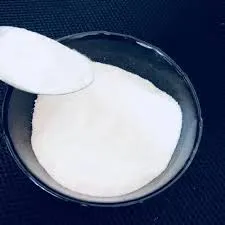
ጥቅም . 12, 2024 04:02 Back to list
Understanding the Solubility Characteristics of Hydroxypropyl Methyl Cellulose in Various Solutions
Understanding Hydroxypropyl Methylcellulose Solubility
Hydroxypropyl methylcellulose (HPMC) is a widely used polymer derived from cellulose, a natural biopolymer. The unique properties of HPMC, notably its solubility in water, make it an essential ingredient in various industrial and pharmaceutical applications. Understanding the factors that influence the solubility of HPMC is crucial for optimizing its use in these fields.
What is Hydroxypropyl Methylcellulose?
HPMC is a modified cellulose that has been chemically altered to enhance its performance in various applications. The modification process involves the substitution of hydroxyl groups in the cellulose chain with hydroxypropyl and methyl groups. This alteration not only changes the physical properties of the molecule but also affects its solubility characteristics in water and organic solvents.
HPMC is a white, odorless powder that is non-toxic and generally recognized as safe (GRAS) for consumption. It is extensively utilized in food products, pharmaceuticals, and personal care items, serving several roles, from acting as a thickening agent and emulsifier to functioning as a film-forming agent and binder.
Solubility Characteristics of HPMC
The solubility of HPMC in water is influenced by several key factors, including molecular weight, degree of substitution, and temperature. HPMC is typically available in different grades, which correspond to varying molecular weights and degrees of hydroxypropyl and methyl substitution.
1. Molecular Weight The molecular weight of HPMC significantly influences its solubility. Low molecular weight HPMC grades dissolve more readily in water compared to higher molecular weight grades, which may require longer agitation or higher temperatures to achieve full solubility. This is partly due to the tendency of larger molecules to entangle, which can inhibit their ability to disperse in water.
hydroxypropyl methyl cellulose solubility

2. Degree of Substitution The degree of substitution refers to the number of hydroxyl groups replaced by hydroxypropyl and methyl groups. A higher degree of substitution typically leads to improved solubility, as the hydrophobic methyl groups can aid in stabilizing the polymer chains in an aqueous environment. Thus, HPMC with a higher degree of substitution will often dissolve more easily than those with lower substitution levels.
3. Temperature Temperature also plays a critical role in the solubility of HPMC. As temperature increases, the kinetic energy of the water molecules increases, enhancing their capacity to break apart the intermolecular forces holding the HPMC chains together. Therefore, heating the solution can accelerate the dissolution process, although care must be taken not to exceed the polymer’s thermal stability limits.
Applications and Importance
The solubility of HPMC makes it an invaluable asset across various industries. In the pharmaceutical industry, for instance, HPMC is commonly used as a binder in tablet formulations and as a viscosity-enhancing agent in liquid preparations. The polymer's ability to form gels when dissolved allows for controlled release of active ingredients, leading to improved therapeutic outcomes.
In the food industry, HPMC serves many functions, such as thickening agents or emulsifiers in sauces, dressings, and bakery products, enhancing texture and consistency. Its vegetarian nature makes it a suitable alternative to gelatin, further expanding its application range.
Additionally, HPMC is utilized in construction materials as a water-retaining agent in mortars and plasters, helping improve workability and extending setting times.
Conclusion
In conclusion, the solubility of hydroxypropyl methylcellulose is a critical property that underpins its versatile applications across various fields. With an understanding of the factors influencing its solubility—including molecular weight, degree of substitution, and temperature—manufacturers can better tailor HPMC for specific applications. As research continues to evolve, the potential uses of HPMC are likely to expand even further, reinforcing its role as a vital component in both consumer products and industrial processes.
-
Versatile Hpmc Uses in Different Industries
NewsJun.19,2025
-
Redispersible Powder's Role in Enhancing Durability of Construction Products
NewsJun.19,2025
-
Hydroxyethyl Cellulose Applications Driving Green Industrial Processes
NewsJun.19,2025
-
Exploring Different Redispersible Polymer Powder
NewsJun.19,2025
-
Choosing the Right Mortar Bonding Agent
NewsJun.19,2025
-
Applications and Significance of China Hpmc in Modern Industries
NewsJun.19,2025







